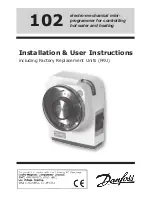
micro
HAM ©
2016
All rights reserved
The current subselection is indicated by LEDs above the
buttons [1]-[4]. If the controlled point is an antenna (vertical
array), the pattern of LEDs is governed by a table in Directions
subtab of RF box. In addition, the displayed azimuth and
corresponding compass arrow (LCD display, pos.4 and 5)
follow the selected direction. When the controlling point is a
switch (stack controller) the LED patterns are given directly by
the lower 4 bits of current inVector and a set of “boxes” shows
the current subpath (LCD display, pos.6) on the LCD.
Controlling rotators
When there are any antennas with associated rotators on the
active path, turning the rotary encoder (Front panel, pos.16)
clockwise or counter clockwise will set the target azimuth for
those rotators. However, the encoder provides access to
several other features:
•
Dynamic control
If the encoder is turned slowly, the azimuth is set in one degree steps. If the encoder is turned quickly
the azimuth is adjusted; in 10 degree steps. This allows making large changes in azimuth with less
movement of the encoder.
•
Quick Start, Immediate Stop
When the azimuth is set to a value larger than the “dead zone,” the rotator will begin turning one second
after the encoder stops moving. If the encoder knob is pressed and released after setting a new azimuth
the rotator will begin moving immediately. If the encoder is pressed while the rotator is turning, it will stop
but the target azimuth will be retained and rotation can
be resumed by pressing and releasing the encoder or
a new target may be set by rotating the encoder.
•
Memory Jump
The four programmable memory positions may be
recalled by pressing and holding the encoder and
rotating clockwise. The rotator will start moving when
the knob is released.
•
Position Jump
If the encoder knob is depressed and held while the
knob is rotated counter clockwise the azimuth can be
set in 45 degree increments. The first position is [LP]
which will turn the antenna 180 degrees from its
current heading. The other positions are show in
compass mode.
Alternatively, the target azimuth for rotators can be sent to SMD from any software capable of controlling DCU-1
rotators via the Router.
Alternative Antenna Paths (ALT)
In a complex setup, multiple paths can exist from a particular
radio port to a given antenna. These paths are automatically
recognized by the Router while entering the setup and they
are logically merged and presented to the user as a single
antenna selection.
81
The same stack-type of path is now accessed through a
second R-port (SUB), which is indicated by the cross in the
"box" corresponding to the connected A-port
While turning the rotary encoder to control rotators, the target
azimuth is displayed in large digits.
When pressing the encoder and turning it clockwise, one of
four "memory" azimuth positions can be selected.
When pressing the encoder and turning it counter-clockwise,
one of the “compass” azimuth positions can be selected.
SMD is in TX-split state, indicated by dot above Rx. For RX
path, alternative 1 (indicated as ALT 1), for Tx path,
alternative 2 (ALT 2) of the same antenna selection is set.
















































